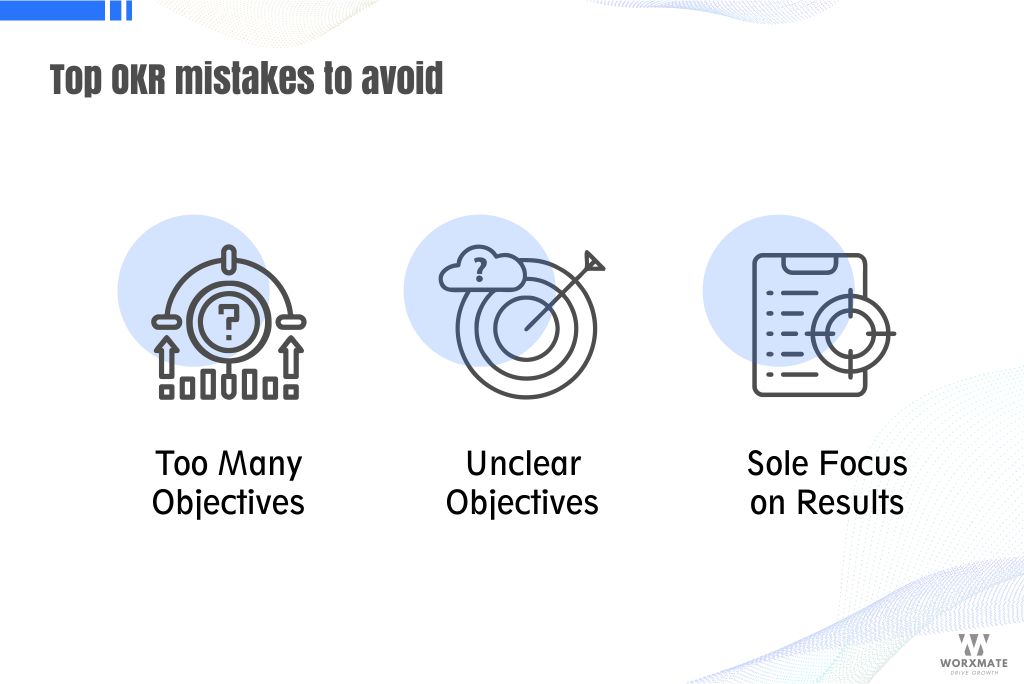Embarking on the journey of implementing Objectives and Key Results (OKRs) marks a pivotal moment for any organization, laden with both anticipation and challenges.
Implementing OKRs, while popular and perceived as effective, guarantees success only when executed correctly and implemented with precision. Numerous pitfalls can hinder their efficacy, leading to frustration, disengagement, and ultimately, failure to achieve desired outcomes.
In this comprehensive guide, we delve into the top mistakes to avoid when implementing OKRs, offering insights and strategies to navigate these challenges successfully. Whether you’re a seasoned leader or just dipping your toes into the world of OKRs, understanding and sidestepping these common missteps will be instrumental in harnessing the full potential of this goal-setting framework.

Let’s explore the intricacies of OKR implementation, shedding light on prevalent mistakes organizations should steer clear of to fully capitalize on the potential of their OKR endeavors.
Setting too many objectives
A common pitfall organizations encounter when implementing OKRs is the temptation to set too many objectives. While it may seem enticing to tackle numerous initiatives simultaneously, spreading focus too thinly can dilute effectiveness and hinder progress.
Instead, prioritize a select few objectives that align closely with your overarching goals and strategic priorities. By concentrating efforts on a manageable number of key objectives, you can ensure that resources are allocated efficiently and teams remain focused on what truly matters.
The ideal number of OKR objectives that a company should set typically ranges between 2 to 3 Objectives, each with 3 to 5 corresponding Key Results. This recommendation is based on the principle that less is more when it comes to OKRs. This allows for clear focus and alignment, ensuring that efforts are directed towards achieving meaningful outcomes.
Lack of clarity in objectives
One of the most common mistakes organizations make when implementing OKRs is setting vague or overly broad objectives. Without clear and specific objectives, it becomes challenging for teams to align their efforts and track progress effectively.
To avoid this pitfall, ensure that each objective is specific, measurable, achievable, relevant, and time-bound (SMART). Clearly define the desired outcomes and key results that will indicate success, providing teams with a clear roadmap to follow.
Focusing solely on results
While the ‘R’ in OKRs stands for results, it’s essential not to overlook the importance of objectives themselves. Some organizations make the mistake of prioritizing results at the expense of setting meaningful objectives.
Remember that objectives provide context and direction for your key results, guiding teams toward achieving the desired outcomes. Strike a balance between setting ambitious but achievable objectives and defining measurable key results that will drive progress to achieve those objectives.
Failure to cascade OKRs effectively
OKRs are most effective when they cascade seamlessly from top-level organizational goals down to individual team and employee objectives. However, many organizations struggle with cascading OKRs effectively across different levels of the organization.
To avoid this mistake, ensure alignment between organizational, departmental, team, and individual OKRs. Establish clear linkages between higher-level objectives and lower-level objectives, fostering alignment and accountability throughout the organization.
Neglecting regular review and iteration
OKRs are dynamic and necessitate consistent evaluation and refinement to maintain their relevance and efficacy. Regrettably, certain organizations fall into the trap of adopting a “set it and forget it” approach, delaying OKR reviews until the end of a quarter or year.
To optimize OKRs‘ effectiveness, establish a rhythm for frequent check-ins and progress assessments. Foster open dialogue and transparency, enabling teams to gauge their advancement, recognize challenges, and adapt strategies as necessary to ensure steady progress toward goal attainment.
Overemphasizing individual performance
While OKRs are a valuable tool for driving individual performance, they are most effective when viewed through a lens of collective achievement and collaboration. Avoid the mistake of overemphasizing individual performance at the expense of team cohesion and collaboration.
Encourage a culture of shared accountability where teams work together towards common goals, supporting one another, and celebrating collective successes. Recognize that achieving objectives often requires cross-functional collaboration and alignment across teams.
Overlooking the Importance of transparency and accountability
Research from Harvard Business Review highlights that employees in high-trust workplaces exhibit 76% higher engagement and 29% greater life satisfaction. Therefore, transparency and accountability emerge as foundational principles for successful OKR implementation.
Overlooking these aspects can undermine the effectiveness of the entire process. Leaders must cultivate a culture of openness and transparency where OKRs are openly shared across teams and progress is visible to all stakeholders.
Furthermore, accountability should be woven into the organizational fabric, with clear expectations regarding individual and team responsibilities for achieving OKRs.
Treating OKRs as static targets rather than dynamic guides
Finally, a common mistake is treating OKRs as static targets set in stone at the beginning of a planning period. In reality, OKRs should be viewed as dynamic guides that evolve in response to changing circumstances and priorities.
Embrace a mindset of flexibility and adaptability, allowing for adjustments to OKRs based on new insights, market conditions, or organizational shifts. By remaining agile and responsive, you can ensure that OKRs remain relevant and impactful throughout the planning cycle.
Conclusion
In summary, the implementation of Objectives and Key Results (OKRs) offers organizations a transformative journey toward enhanced focus, alignment, and performance. By steering clear of the common mistakes outlined in this guide and wholeheartedly embracing best practices, organizations can unlock the full potential of OKRs to drive strategic success.
Effectively aligning OKRs with overarching organizational goals, maintaining transparency and accountability, and fostering a culture of adaptability and continuous improvement are key tenets of successful implementation. By doing so, organizations can not only maximize the effectiveness of their OKR initiatives but also pave the way for sustainable growth and success in the long term.
So, as you embark on your OKR journey, remember to heed these insights, remain vigilant against potential pitfalls, and approach each step with confidence and clarity, knowing that you’re charting a course toward a brighter and more prosperous future.




